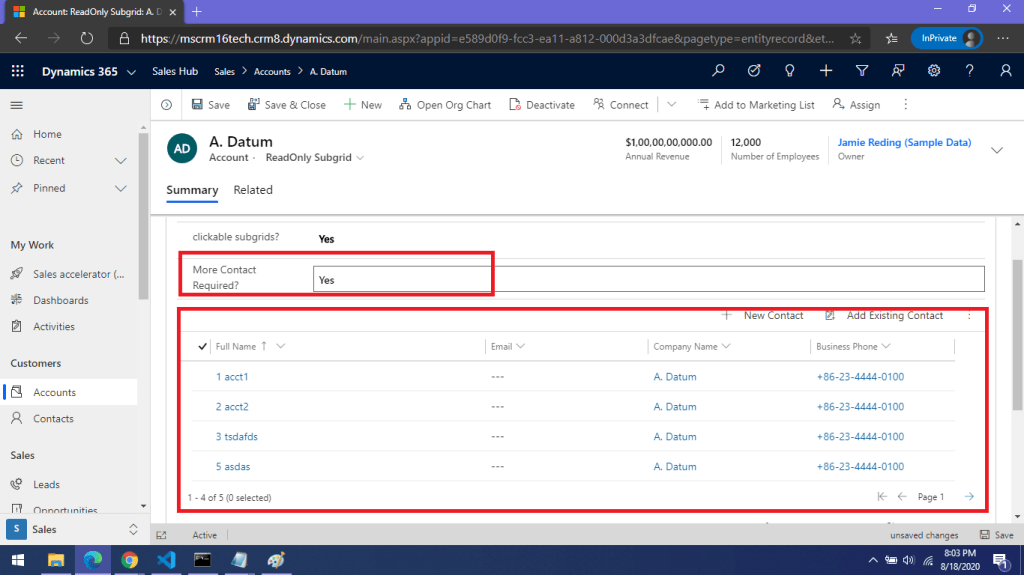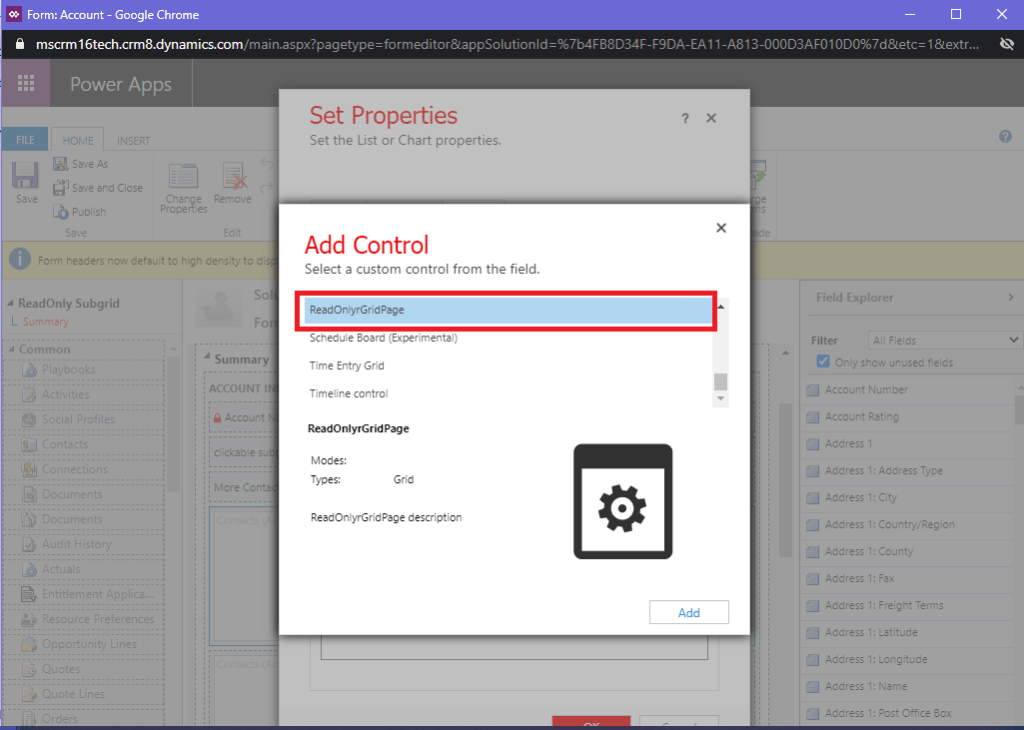What is Issue?
Performing CRUD operation on Dynamics 365 CRM using API (Rest/ODATA) from other applications.
The Reason-
While performing integration of other application with CRM, creating custom Web API and webservice is having much efforts in terms of time and development. Microsoft already made developers job easy by providing the ODATA API available for their products. How to consume that API in other applications.
Solution-
While performing integration of other application with CRM, rather than creating the custom API or webservice, we can utilize ODATA APIs that can be consumed with the OAuth 2.0 authentication.
Lets take .net application which is consuming ODATA API.
Some time we don’t want to include any third party dll due to some environmental restrictions. so the sample code added below is using only system libraries.
(In case of Json serialization, you can utilize Newtonsoft.Json to avoid the classes to be written manually)
Create records using ODATA API-
#region Create API Call
/// <summary>
/// Create the entity Record using API Call
/// </summary>
/// <param name="entityname">entity Name</param>
/// <param name="entity">entity Object with parameter values</param>
/// <returns></returns>
public string CreateAPI(string entityname, object entity)
{
string funResponse = null;
string query = entityname;
string crmRestQuery = apiUrl + query;
try
{
using (MemoryStream streamOpportunitySerialize = new MemoryStream())
{
DataContractJsonSerializer ser = new DataContractJsonSerializer(entity.GetType());
ser.WriteObject(streamOpportunitySerialize, entity);
streamOpportunitySerialize.Position = 0;
StreamReader srOpportunity = new StreamReader(streamOpportunitySerialize);
string objectJSON = srOpportunity.ReadToEnd();
objectJSON = objectJSON.Replace("_odata_bind", "@odata.bind");
HttpRequestMessage request = new HttpRequestMessage(HttpMethod.Post, crmRestQuery);
//add header parameters
request.Headers.Add("Authorization", "Bearer " + oauthToken);
request.Content = new StringContent(objectJSON);
request.Content.Headers.ContentType = MediaTypeHeaderValue.Parse("application/json; charset=utf-8");
HttpResponseMessage response = httpClient.SendAsync(request).Result;
string responseString = response.Content.ReadAsStringAsync().Result;
if (response.IsSuccessStatusCode)
{
string _recordUrl = response.Headers.GetValues("OData-EntityId").FirstOrDefault();
string[] splitRetrievedData = _recordUrl.Split('[', '(', ')', ']');
funResponse = splitRetrievedData[1];
}
else
funResponse = responseString;
}
}
catch (Exception ex)
{
funResponse = ex.Message;
}
return funResponse;
}
#endregion
Update records using ODATA API-
#region Update API Call
/// <summary>
/// Update the entity record using API Call
/// </summary>
/// <param name="entityname">entity name</param>
/// <param name="entityid">entity id</param>
/// <param name="entity">entity Object with parameter values</param>
/// <returns></returns>
public string UpdateAPI(string entityname, string entityid, object entity)
{
string funResponse = null;
string query = entityname + "(" + entityid + ")";
string crmRestQuery = apiUrl + query;
try
{
using (MemoryStream streamOpportunitySerialize = new MemoryStream())
{
DataContractJsonSerializer ser = new DataContractJsonSerializer(entity.GetType());
ser.WriteObject(streamOpportunitySerialize, entity);
streamOpportunitySerialize.Position = 0;
StreamReader srOpportunity = new StreamReader(streamOpportunitySerialize);
string objectJSON = srOpportunity.ReadToEnd();
objectJSON = objectJSON.Replace("_odata_bind", "@odata.bind");
HttpMethod method = new HttpMethod("PATCH");
HttpRequestMessage request = new HttpRequestMessage(method, crmRestQuery);
//add header parameters
request.Headers.Add("Authorization", "Bearer " + oauthToken);
request.Headers.Add("If-Match", "*"); //preventing creation of new record if no record found with ID
request.Content = new StringContent(objectJSON);
request.Content.Headers.ContentType = MediaTypeHeaderValue.Parse("application/json; charset=utf-8");
HttpResponseMessage response = httpClient.SendAsync(request).Result;
string responseString = response.Content.ReadAsStringAsync().Result;
if (response.IsSuccessStatusCode)
{
funResponse = "Sucessfully Updated Record!!";
}
else
funResponse = responseString;
}
}
catch (Exception ex)
{
funResponse = ex.Message;
}
return funResponse;
}
#endregion
Delete records using ODATA API-
#region Delete API Call
/// <summary>
/// Delete the entity Record using API Call
/// </summary>
/// <param name="entityname">entity Name</param>
/// <param name="entityid">Entity id</param>
/// <returns></returns>
public string DeleteAPI(string entityname, string entityid)
{
string funResponse = null;
string query = entityname + "(" + entityid + ")";
string crmRestQuery = apiUrl + query;
try
{
HttpRequestMessage request = new HttpRequestMessage(HttpMethod.Delete, crmRestQuery);
//add header parameters
request.Headers.Add("Authorization", "Bearer " + oauthToken);
request.Headers.Add("Accept", "application/json; charset=utf-8");
HttpResponseMessage response = httpClient.SendAsync(request).Result;
string responseString = response.Content.ReadAsStringAsync().Result;
if (response.IsSuccessStatusCode)
funResponse = "Deleted!!!";
else
funResponse = responseString;
}
catch (Exception ex)
{
funResponse = ex.Message;
}
return funResponse;
}
#endregion
Retrieve Single record using ODATA API-
/// <summary>
/// Retrieve single using API Call
/// </summary>
/// <param name="entityPluralName">entity Name</param>
/// <param name="entityId">entity id</param>
/// <param name="entityObject">blank entity object</param>
/// <param name="selectColumns">select columns to retrieve in API Call</param>
/// <returns>Object of entity</returns>
public object RetrieveSingle(string entityPluralName,string entityId,object entityObject, string selectColumns=null)
{
string query = "("+entityId+")";
if (selectColumns != null) {
query += "?$select=" + selectColumns;
}
string crmRestQuery = apiUrl + entityPluralName + query;
try
{
HttpRequestMessage request = new HttpRequestMessage(HttpMethod.Get, crmRestQuery);
//add header parameters
request.Headers.Add("Prefer", "odata.include-annotations=\"*\"");//for formatted values
request.Headers.Accept.Add(new MediaTypeWithQualityHeaderValue("application/XML"));
request.Headers.Add("Authorization", "Bearer " + oauthToken);
//send request
HttpResponseMessage response = httpClient.SendAsync(request).Result;
string responseString = response.Content.ReadAsStringAsync().Result;
responseString = FormatResponse(responseString);
using (var ms = new MemoryStream(Encoding.Unicode.GetBytes(responseString)))
{
// Deserialization from JSON
DataContractJsonSerializer deserializer = new DataContractJsonSerializer(entityObject.GetType());
entityObject = (object)deserializer.ReadObject(ms);
}
}
catch (Exception ex){ throw ex; }
return entityObject;
}
Retrieve Multiple records using ODATA API-
/// <summary>
/// Retrieve multiple using Fetch XML in API Call
/// </summary>
/// <param name="entityPluralName">entity name</param>
/// <param name="fetchXML">fetchXML string</param>
/// <returns>List of retrieved Objects</returns>
public List<RetrieveOpportunity> RetrieveMultiple(string entityPluralName, string fetchXML)
{
fetchXML = fetchXML.Replace("<fetch", "<fetch {0} ");
int page = 1;
var cookie = string.Format("page='{0}'", page);
string xml = string.Format(fetchXML, cookie);
string crmRestQuery = apiUrl + entityPluralName + "?fetchXml=" + xml;
List<RetrieveOpportunity> lstOpties = new List<RetrieveOpportunity>();
bool isDone = false;
try
{
while (isDone == false)
{
isDone = true;
HttpRequestMessage request = new HttpRequestMessage(HttpMethod.Get, crmRestQuery);
//add header parameters
request.Headers.Add("Prefer", "odata.include-annotations=\"*\"");//for formatted values
request.Headers.Accept.Add(new MediaTypeWithQualityHeaderValue("application/XML"));
request.Headers.Add("Authorization", "Bearer " + oauthToken);
//send request
HttpResponseMessage response = httpClient.SendAsync(request).Result;
string responseString = response.Content.ReadAsStringAsync().Result;
responseString = FormatResponse(responseString);
using (var ms = new MemoryStream(Encoding.Unicode.GetBytes(responseString)))
{
// Deserialization from JSON
DataContractJsonSerializer deserializer = new DataContractJsonSerializer(typeof(APIResult));
APIResult apiResult = (APIResult)deserializer.ReadObject(ms);
if (!string.IsNullOrEmpty(apiResult.Microsoft_Dynamics_CRM_fetchxmlpagingcookie))
{
isDone = false;
page++;
//retrieve pagingCookie value
string xmlVal = WebUtility.UrlDecode((WebUtility.UrlDecode((string)apiResult.Microsoft_Dynamics_CRM_fetchxmlpagingcookie)));
int Start = xmlVal.IndexOf("pagingcookie=\"", 0) + "pagingcookie=\"".Length;
int End = xmlVal.IndexOf("\" istracking=\"False\"", Start);
//proccess the pagingCookie value to support in API URL
string strVal = xmlVal.Substring(Start, End - Start).Replace("<", "%26lt;").Replace(">", "%26gt;").Replace("\"", "%26quot;").Replace("'", "%26apos;").Replace("&", "%26amp;");
cookie = string.Format("page='{0}' paging-cookie='{1}'", page, strVal);
//modify the query for next page with paging cookie
xml = string.Format(fetchXML, cookie);
crmRestQuery = apiUrl + entityPluralName +"?fetchXml=" + xml;
}
if (!string.IsNullOrEmpty(apiResult.odata_nextLink))
{
isDone = false;
crmRestQuery = apiResult.odata_nextLink;
}
if (lstOpties == null || lstOpties.Count == 0)
{
lstOpties = apiResult.value;
}
else
{
lstOpties.AddRange(apiResult.value);
}
}
}
}
catch (Exception ex) {
throw ex;
}
return lstOpties;
}
public List<RetrieveOpportunity> RetrieveMultiple(string entityPluralName, string selectColumns,string filterConditions=null, string orderby=null,bool returnCount=false)
{
string query= "?$select=" + selectColumns;
if (filterConditions != null) {
query += "&$filter=" + filterConditions;
}
if (orderby != null) {
query += "&$orderby=" + orderby;
}
if (returnCount == true) {
query += "&$count=true";
}
string crmRestQuery = apiUrl + entityPluralName + query;
List<RetrieveOpportunity> lstOpties = new List<RetrieveOpportunity>();
bool isDone = false;
try
{
while (isDone == false)
{
isDone = true;
HttpRequestMessage request = new HttpRequestMessage(HttpMethod.Get, crmRestQuery);
//add header parameters
request.Headers.Add("Prefer", "odata.include-annotations=\"*\"");//for formatted values
request.Headers.Accept.Add(new MediaTypeWithQualityHeaderValue("application/XML"));
request.Headers.Add("Authorization", "Bearer " + oauthToken);
//send request
HttpResponseMessage response = httpClient.SendAsync(request).Result;
string responseString = response.Content.ReadAsStringAsync().Result;
responseString = FormatResponse(responseString);
using (var ms = new MemoryStream(Encoding.Unicode.GetBytes(responseString)))
{
// Deserialization from JSON
DataContractJsonSerializer deserializer = new DataContractJsonSerializer(typeof(APIResult));
APIResult apiResult = (APIResult)deserializer.ReadObject(ms);
if (!string.IsNullOrEmpty(apiResult.odata_nextLink))
{
isDone = false;
crmRestQuery = apiResult.odata_nextLink;
}
if (lstOpties == null || lstOpties.Count == 0)
{
lstOpties = apiResult.value;
}
else
{
lstOpties.AddRange(apiResult.value);
}
}
}
}
catch (Exception ex)
{
throw ex;
}
return lstOpties;
}
Some common Methods in above Code –
#region Local variables
/// <summary>
/// Local Variables
/// </summary>
private string clientID, secretKey, resource, oauthToken, apiUrl, tokenURL;
private HttpClient httpClient;
/// <summary>
/// Constructor to initialize the variables
/// </summary>
public Operations()
{
apiUrl = "https://mscrm16tech.crm8.dynamics.com/api/data/v8.2/";
clientID = "xxxxxxxx-xxxx-xxxx-xxxx-xxxxxxxxxxxx";
secretKey = "asdasdxzxczdsdaasda";
resource = "https://mscrm16tech.crm8.dynamics.com";
tokenURL = "https://login.microsoftonline.com:443/xxxxxxxx-xxxx-xxxx-xxxx-xxxxxxxxxxxx/oauth2/token/";
}
#endregion
#region Generate Bearer Token
/// <summary>
/// Function to generate Bearer token OAuth2.0 using client id and secret
/// </summary>
/// <returns>access token</returns>
public string GetBearerToken()
{
oauthToken = null;
HttpClientHandler clientHandler = new HttpClientHandler();
clientHandler.Proxy = WebRequest.GetSystemWebProxy();
clientHandler.Proxy.Credentials = CredentialCache.DefaultCredentials; // or new NetworkCredential("username","password","DOMAIN");
clientHandler.UseProxy = true;
httpClient = new HttpClient(clientHandler);
ServicePointManager.SecurityProtocol = SecurityProtocolType.Tls12;
HttpContent requestContent = new FormUrlEncodedContent(new Dictionary<string, string>
{
{"grant_type","client_credentials"},
{"client_id",clientID},
{"client_secret",secretKey},
{"resource",resource}
}
);
HttpResponseMessage response = httpClient.PostAsync(tokenURL, requestContent).Result;
String responseString = response.Content.ReadAsStringAsync().Result;
using (var ms = new MemoryStream(Encoding.Unicode.GetBytes(responseString)))
{
// Deserialization from JSON
DataContractJsonSerializer deserializer = new DataContractJsonSerializer(typeof(BearerToken));
BearerToken token = (BearerToken)deserializer.ReadObject(ms);
oauthToken = token.access_token;
}
return oauthToken;
}
#endregion
#region Common Methods
public string FormatResponse(string responseString) {
responseString = responseString.Replace("@odata.etag", "odata_etag");
responseString = responseString.Replace("@OData.Community.Display.V1.FormattedValue", "_OData_Community_Display_V1_FormattedValue");
responseString = responseString.Replace("@Microsoft.Dynamics.CRM.associatednavigationproperty", "_Microsoft_Dynamics_CRM_associatednavigationproperty");
responseString = responseString.Replace("@Microsoft.Dynamics.CRM.lookuplogicalname", "_Microsoft_Dynamics_CRM_lookuplogicalname");
responseString = responseString.Replace("@Microsoft.Dynamics.CRM.lookuplogicalname", "_Microsoft_Dynamics_CRM_lookuplogicalname");
responseString = responseString.Replace("@odata.context", "odata_context");
responseString = responseString.Replace("@Microsoft.Dynamics.CRM.totalrecordcount", "Microsoft_Dynamics_CRM_totalrecordcount");
responseString = responseString.Replace("@Microsoft.Dynamics.CRM.totalrecordcountlimitexceeded", "Microsoft_Dynamics_CRM_totalrecordcountlimitexceeded");
responseString = responseString.Replace("@Microsoft.Dynamics.CRM.fetchxmlpagingcookie", "Microsoft_Dynamics_CRM_fetchxmlpagingcookie");
responseString = responseString.Replace("@Microsoft.Dynamics.CRM.morerecords", "Microsoft_Dynamics_CRM_morerecords");
responseString = responseString.Replace("@odata.nextLink", "odata_nextLink");
return responseString;
}
#endregion
Sample Class for Json Serialization in API Calls-
This class is not needed in you are using Newtonsoft.Json library.
using System.Collections.Generic;
using System.Runtime.Serialization;
namespace ODATA_API
{
[DataContract]
public class BearerToken
{
[DataMember]
public string token_type;
[DataMember]
public string expires_in;
[DataMember]
public string ext_expires_in;
[DataMember]
public string expires_on;
[DataMember]
public string not_before;
[DataMember]
public string resource;
[DataMember]
public string access_token;
}
[DataContract]
public class CreateUpdateOpportunity {
[DataMember]
public string name;
[DataMember]
public string estimatedclosedate;
[DataMember]
public string parentaccountid_odata_bind;
[DataMember]
public decimal estimatedvalue;
[DataMember]
public string transactioncurrencyid_odata_bind;
}
[DataContract]
public class RetrieveOpportunity
{
[DataMember]
public string _odata_context;
[DataMember]
public string _odata_etag;
[DataMember]
public string estimatedclosedate_OData_Community_Display_V1_FormattedValue;
[DataMember]
public string estimatedclosedate;
[DataMember]
public string estimatedvalue_OData_Community_Display_V1_FormattedValue;
[DataMember]
public string estimatedvalue;
[DataMember]
public string estimatedvalue_base_OData_Community_Display_V1_FormattedValue;
[DataMember]
public string estimatedvalue_base;
[DataMember]
public string name;
[DataMember]
public string _parentaccountid_value_OData_Community_Display_V1_FormattedValue;
[DataMember]
public string _parentaccountid_value;
[DataMember]
public string opportunityid;
[DataMember]
public string _transactioncurrencyid_value_OData_Community_Display_V1_FormattedValue;
[DataMember]
public string _transactioncurrencyid_value;
}
[DataContract]
public class APIResult
{
[DataMember]
public string odata_context;
[DataMember]
public int Microsoft_Dynamics_CRM_totalrecordcount;
[DataMember]
public bool Microsoft_Dynamics_CRM_totalrecordcountlimitexceeded;
[DataMember]
public string Microsoft_Dynamics_CRM_fetchxmlpagingcookie;
[DataMember]
public bool Microsoft_Dynamics_CRM_morerecords;
[DataMember]
public string odata_nextLink;
[DataMember]
public List<RetrieveOpportunity> value;
}
}
Calling the Above methods Sample-
static void Main(string[] args)
{
Operations ops = new Operations();
Console.WriteLine("Started!!");
Console.WriteLine(ops.GetBearerToken());
CreateUpdateOpportunity entity = new CreateUpdateOpportunity();
entity.transactioncurrencyid_odata_bind = "/transactioncurrencies(c63ba581-6bc6-e811-a96f-000d3af04fb0)";
entity.estimatedvalue = 1000;
entity.estimatedclosedate = "2021-01-01";
entity.name = "Generated From C# Code";
entity.parentaccountid_odata_bind = "/accounts(3b3b7c71-61d2-ea11-a813-000d3af0205e)";
//create record
string recordGuid = ops.CreateAPI("opportunities", entity);
Console.WriteLine(recordGuid);
//update record
entity.name = "Generated From CSharp Code";
Console.WriteLine(ops.UpdateAPI("opportunities", recordGuid, entity));
//retrieve record
RetrieveOpportunity retrieveOpportunity = new RetrieveOpportunity();
retrieveOpportunity =(RetrieveOpportunity)ops.RetrieveSingle("opportunities", recordGuid,retrieveOpportunity);
Console.WriteLine(retrieveOpportunity.name);
//delete Record
Console.WriteLine(ops.DeleteAPI("opportunities", recordGuid));
Console.Read();
}
Hope this will help…
Enjoy Ms CRM!!!
Follow on Facebook- FB: MSCRM16Tech










